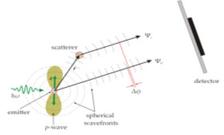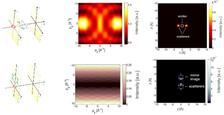Photoelectron holography. A photon of energy ![]() (linear polarized) is absorbed (K-shell) by an atom serving as an emitter of a photoelectron p-wave. The direct wave, Y0, interferes with the object wave, YS, from the scatterer (one of the atoms in the molecule). Such scattering events are summed over all molecular atoms j = 1,…N yielding an intensity distribution I = ïY0 +SiYSï2, which represents a hologram that can be measured over a large portion of photoelectron momentum-space (Krasniqi2010).
(linear polarized) is absorbed (K-shell) by an atom serving as an emitter of a photoelectron p-wave. The direct wave, Y0, interferes with the object wave, YS, from the scatterer (one of the atoms in the molecule). Such scattering events are summed over all molecular atoms j = 1,…N yielding an intensity distribution I = ïY0 +SiYSï2, which represents a hologram that can be measured over a large portion of photoelectron momentum-space (Krasniqi2010).
Photoelectron holography (as well as Auger electron holography) is a special case of photoelectron diffraction, where high-kinetic energy electrons are used to record photoelectron holograms that can be directly reconstructed to yield real-space images of the environment surrounding the photoelectron emitter (Barton1988, Fadley2001, Fadley2008). While the technique was developed and is being used in solid state and surface physics, holograms of gas-phase molecules have not been recorded to date, despite the great potential that this method has for directly imaging photochemical reactions of gas-phase molecules in femtosecond pump-probe experiments. Using the photoelectron-photoion-coincidence technique to orient and align gas-phase molecules (see Photoelectron-Photoion Coincidence Experiments with Synchrotron Radiation), we plan to establish photoelectron holography of free gas-phase molecules using synchrotron radiation with the goal of transferring this technique to Free-Electron Lasers in order to perform time-resolved photoelectron holography experiments [Krasniqi2010, Rolles2013].
Own References:
F. Krasniqi, B. Najjari, L. Strüder, D. Rolles, A. Voitkiv, and J. Ullrich, Imaging molecules from within: Ultrafast angström-scale structure determination of molecules via photoelectron holography using free-electron lasers, Phys. Rev. A 81, 033411 (2010).
D. Rolles, Trendbericht Physikalische Chemie 2012: Molekülkino – Experimente mit Freie-Elektronen-Lasern, Nachr. a. d. Chemie 61, 313 (2013).
Other relevant publications in the research field:
J. J. Barton, Photoelectron Holography, Phys. Rev. Lett. 61, 1356 (1988).
C. S. Fadley, M. A. Van Hove, A. Kaduwela, S. Omori, L. Zhao, S. Marchesini, Photoelectron and x-ray holography by contrast: enhancing image quality and dimensionality, J. Phys.: Condens. Matter 13 10517 (2001).
C. S. Fadley, Atomic-level characterization of materials with core- and valence-level photoemission: basic phenomena and future directions, Surf. Interface Anal. 40, 1579–1605 (2008).







